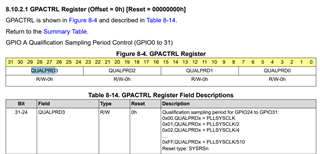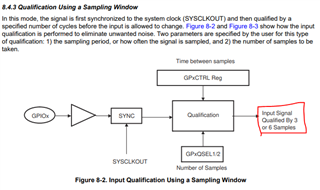Tool/software:
HI
I am using eqep module to calculate speed and postion
first question is :1) what is min qualprd should to take at high speed (250 )[ eqep data : teeth =36,freq=255 Hz, Time = 0.006667 sec]in gpio qualification beacuse at high speed there may spikes and might there is chance that gpio cant filter or miss that spike due to high speed. if this assumption is true what is min qualprd should be taken and sampling window for 6 samples
question : 2) if i want to take sampling window of 0.006667 sec as mentioned in Question 1 (on and off time of a pulse) with 6 samples i am getting Qualprd of 134000 which is not possible since qualprd is 8 bit reg so max value is 255. how to over this issue?




